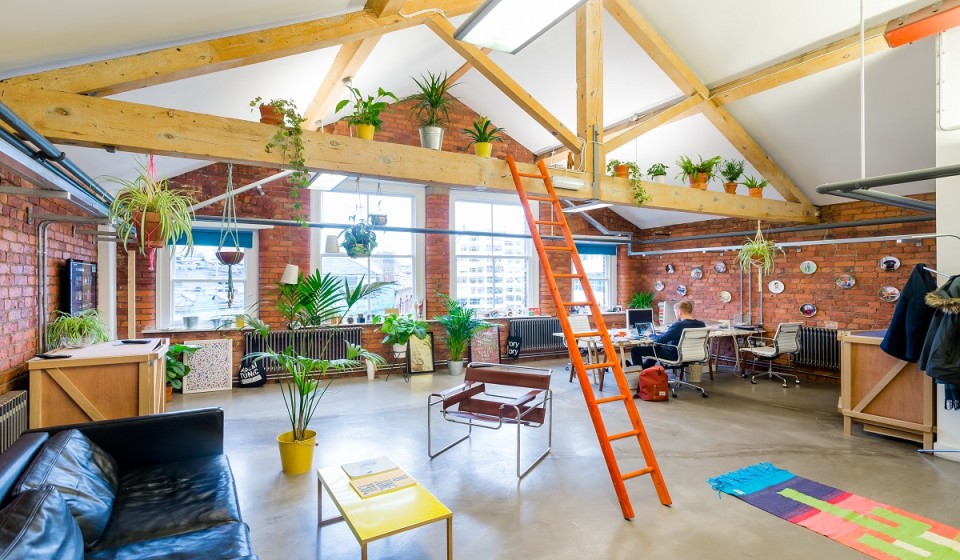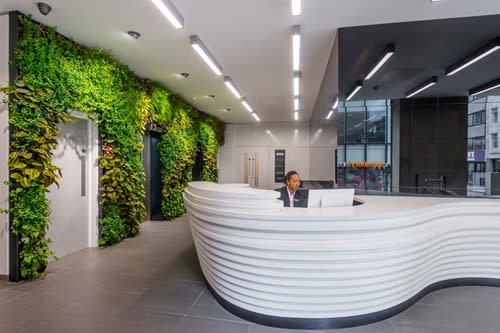Office space design: Biophilla
By Bruntwood

The world we live in is becoming increasingly urban, with digital technologies and industrial architecture now a part of everyday life. In the UK alone, over 80% of us live in urban areas, automatically reducing our connection to nature.
But, as humans, we are intrinsically connected to nature, we all have ‘biophilia’, literally translated as ‘love of nature’. It is with this in mind that more designers are bringing biophilia, through biophilic design, into the workplace.
We were recently visited by sustainable architectural and interior design expert, Oliver Heath, who came to discuss how a human-centred, biophilic design approach can improve health and wellbeing.
“Biophilic design, for me, is about how we bring a sense of nature into the most stressful places in our lives; these dense, urban cities, the places where we work, commute, and interact with one another,” explains Oliver. "These design principles allow us to use this connection, bringing a sense of nature into spaces, to make people feel happier, calmer and more relaxed."
The majority of human evolution has been spent in nature, with warmth, shelter, security, access to food and water, and a sense of community all being fundamental to human survival. It has only been since the industrial revolution that we’ve actually had to adapt to this reduced level of natural connection.
While 20 years ago we might still have worked at a computer, we would have turned around to have a conversation with our colleagues, or look out of the window to daydream. “Now what we’re finding is that as soon as we turn around, we’re looking at our smartphones; we’ve always got this sense of directed attention which means that we’re never really giving ourselves the opportunity to switch off,” says Oliver. “That opportunity is so important as a means of recuperating our mental and physical energy after exhausting tasks, but also to regain our cognitive function."

According to a HSE report, stress, depression or anxiety accounted for 40% of all work-related ill health cases in 2016/17 and 49% of absenteeism in the UK. This costs organisations an estimated £29 billion a year. This is where biophilic design really comes into play, with workspace design being directly correlated to enhanced staff wellbeing and productivity. Incorporating natural connections into the workplace can have a huge positive impact on employee performance, creativity and happiness.
There is often little opportunity to bring real nature into buildings, so instead we must aim to mimic nature. Oliver suggests there are seven ways in which we can build real forms of nature into built environments: introducing visual elements of nature through greenery; non-visual stimulation through sound, touch, taste and smell; non-rhythmic sensory stimuli such as ripples across water; connections to the seasons (think Christmas trees!); incorporating water features; thermal airflow variation; and, finally, through natural light.
It is the final element, natural light, that is the most powerful within a human-centred design approach. Natural light is responsible for our circadian rhythms, affecting our mood, behaviour and hormone release. “The problem is that we spend 90% of our lives indoors, continuously exposed to stimulating blue light,” explains Oliver. “As designers we must help and support people to get that exposure to natural light, understanding the dangers of artificial light.”
Oliver suggests reducing the time spent looking at screens, adding colour-changing lightbulbs and simply letting as much natural light into spaces as possible. Workplaces can also support employees exposure to natural light by introducing cycle storage, showers and changing rooms, encouraging an outdoor, physical commute to and from work.
Biophilic design can also be introduced to buildings through the shapes we see in nature. “If you think about gothic churches, they mimic the kind of arches we find in forests and trees,” says Oliver. “Where this idea of biomorphic forms works best is when we provide it in a structural sense, either columns, stairwells or structured steel.”
But this element can also be introduced in the graphic sense. This could be through carpet tiles which use natural materials, textures and patterns, or by adding materials such as timber or green walls.

A research study by Sheppard Robson found that when students learn in rooms with timber walls, their heart rates can be reduced by 8600 beats per day. This showed that students felt more relaxed and comfortable within this environment, and as a result, more able to deal with the learnings of the classroom, rather than dealing with stress.
“It’s really in the workplace where we can accurately measure the benefit of biophilic design,” Oliver goes on to say. “Research has shown it can cut costs and improve outcomes by reducing stress, absenteeism and presentism but also improving outcomes do things like increasing productivity, creativity and connections between staff.”
It is obvious that nature is fantastic for restoring our physical and mental energy, helping us to improve our cognitive abilities. Through creating spaces within the workplace where people can sit and work with a connection to nature, we are able to have moments of recuperation, allowing us to work better and for longer. Simple ways of doing this are by moving desks closer to windows, using the interior spaces for meetings where people can be focused on one another, adding artificial gardens and roof light, and introducing more plants to the space.
“I believe that biophilic design is an essential component in the creation of happier and healthy places to live and work, it's better for people, it's better for productivity and it’s better for the planet,” says Oliver. With increased productivity and reduced cost from prevented absenteeism for businesses, alongside a better work-life balance and lower levels of stress for workforces, biophillic design is sure to bring positive benefits to everyone.